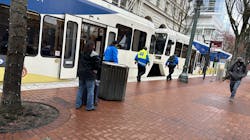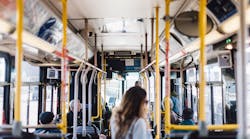UW Study Shows Riders Risk of Secondhand Drug Exposure Minimal; Additional Study is Needed to Assess Risk to Operators
Drug use and transit are two elements that should not be mixed, but transit agencies are finding themselves on the frontlines of a drug crisis that is rapidly intensifying. Transit operators who have observed riders using drugs on their vehicles are concerned about the potential harm this exposure might have. However, there is a lack of information about secondary impacts exposure to smoke or residue from drugs, including fentanyl and methamphetamine, may have on and around transit property and vehicles.
In the U.S., provisional data from the Centers for Disease Control and Prevention found two thirds of the reported 107,081 drug overdose deaths in 2022 involved synthetic opioids. In the Pacific Northwest, the Oregon Health Authority reported the state saw a 330 percent increase in unintentional opioid overdose deaths between 2019 and 2022. University of Washington (UW) analysis found fentanyl was involved in 90 percent of opioid overdoses in Washington state and 65 percent of all overdose deaths.
This mix of concern and limited data prompted five agencies in Washington state and Oregon, including Sound Transit, King County Metro, Community Transit, Everett Transit and TriMet, to fund a study performed by UW to assess levels of fentanyl and methamphetamine in the air and on surfaces in public transportation buses and trains.
The study, “Assessing fentanyl and methamphetamine in the air and on surfaces of transit vehicles,” was released in early September and provided a nuanced answer to the big question surrounding secondhand drug exposure risk while working or riding in a transit system.
As Mass Transit previously reported, the study was “a limited-scope, first-of-its-kind assessment” with the research team finding trace amounts of methamphetamine and fentanyl on surface and air samples. The research team gathered air and surface samples from four agencies during 28 nights along transit lines operators had observed drug use occurring. The team collected 78 air samples and 102 surface samples near operators in and in other areas of the vehicles.
Researchers detected methamphetamine in 98 percent of surface samples and 100 percent of air samples while fentanyl was detected in 46 percent of surface and 25 percent of air samples. One air sample exceeded federal recommendations for airborne fentanyl exposure at work established by the U.S. Environmental Protection Agency. No similar guidelines exist for airborne methamphetamine and no enforceable federal or state regulations exist for either fentanyl or methamphetamine exposures in a workplace.
Marissa Baker, a UW assistant professor of environmental and occupational health sciences who co-led the assessment, explained the research team’s sensitive equipment was more likely to detect drug activity and the detection of substances “does not necessarily mean it poses a health risk to operators or the riding public.”
Dr. Scott Phillips, executive/medical director of the Washington Poison Center, and Dr. Robert G. Hendrickson, program director, fellowship in medical toxicology and medical director for the Oregon Poison Center, issued a joint statement following the release of UW’s assessment, recognizing the presence of drugs in a public space is understandably alarming, but providing a medical perspective to the results.
“The amount of drugs that were detected in this study are extremely small. Exposures to the quantities of drug demonstrated in this study are too small to produce physical effects from a short-term exposure that a rider would experience. Therefore, individuals who use public transportation for travel needs should continue to feel safe doing so,” Dr. Phillips and Dr. Hendrickson said. “The UW study highlights the crisis that communities across the Pacific Northwest and the country are facing - an epidemic of opioid and stimulant use. Our communities must work to address the drivers of substance use and to support and provide help to those with substance use disorders to reach long-term recovery. This study aimed to determine if drugs could be detected in public transit, and it can.”
UW researchers also recognized “further consideration should be given to daily secondhand exposure experienced by operators and its potential for long-term health effects, which have yet to be established by evidence-based research.”
“Operators are different from the riding public because operators are exposed for a much longer time period,” said Marc Beaudreau, a research industrial hygienist in the UW Department of Environmental and Occupational Health Sciences and co-leader of this assessment. “The potential long-term health effects associated with daily exposure have not been adequately researched, so until these relationships are established, we’re suggesting protective measures that transit agencies could implement to keep operators safe.”
The UW team recommended measures, including enhanced surface cleanings, upgrading ventilation and filtration and operator training, such as how to respond to onboard smoking, real and perceived risks of drug exposure and how/when to use naloxone in overdose emergencies.
Mitigation Steps
For the five agencies that funded the UW study, actions and initiatives are being implemented to ensure their transit networks remain safe for riders and employees.
“Our riders, operators and other employees deserve to use our system without being exposed to drug use,” said TriMet General Manager Sam Desue, Jr. “More needs to be done to ensure that transit and other public spaces are safe and comfortable for everyone.”
TriMet has doubled the number of personnel on its security teams, revised its code of conduct to include non-criminal violations of laws as prohibited on TriMet, added a Safety Response Team to connect people in need with social services and the agency will continue cleaning touch points nightly. The agency reports filters were upgraded on its buses and trains during the pandemic with fixed-route buses using MERV-12 rated filters, FX articulated buses using MERV-13 filters and MAX trains using MERV-10 filters, which is the highest level of filter available.
Community Transit and Everett Transit have expanded and enhanced their security procedures. Community Transit has expanded its Transit Security Officer Program, while Everett Transit has partnered with its local police department on a “See Something, Say Something” campaign. Both systems have upgraded their filters and Community Transit is in the process of procuring vendor support to implement a deep cleaning protocol to neutralize drug residue.
Like their regional peers, Sound Transit and King County Metro have also planned to increase security personnel on their systems and will continue work to upgrade filters on vehicles. King County Metro anticipates converting its remaining 448 buses from MERV-11 to MERV-13 filters in the short term. Sound Transit reports it has prioritized MERV-13 filters when possible but explains sometimes the higher-rated filter doesn’t fit while other vehicles are not engineered to handle the filter or may require hardware retrofits before they can be used.
Sound Transit relies on King County Metro for daily maintenance of its link light-rail vehicles and several of its ST Express buses. King County Metro piloted enhanced bus cleaning practices at two bases with plans to expand to all seven of its bases. The enhanced practices include vacuuming with a high-efficiency particulate air filter and implementing a detergent-based deep cleaning of buses every 10-14 days, as well as daily wipe-downs of high-touch areas and the driver’s area.
All five agencies have also implemented steps to ensure offenders observed smoking on vehicles or engaging in other prohibited conduct can be reported and addressed.
“The safety of our staff, our riders and our community is always our highest priority,” said Sound Transit CEO Julie Timm. “While this is the underlying motivation for Sound Transit’s commissioning of this study last year, it is also the reason why we did not wait to increase our security presence and to start pilot partnerships with support services on our system earlier this year.”

Mischa Wanek-Libman | Group Editorial Director
Mischa Wanek-Libman is director of communications with Transdev North America. She has more than 20 years of experience working in the transportation industry covering construction projects, engineering challenges, transit and rail operations and best practices.
Wanek-Libman has held top editorial positions at freight rail and public transportation business-to-business publications including as editor-in-chief and editorial director of Mass Transit from 2018-2024. She has been recognized for editorial excellence through her individual work, as well as for collaborative content.
She is an active member of the American Public Transportation Association's Marketing and Communications Committee and served 14 years as a Board Observer on the National Railroad Construction and Maintenance Association (NRC) Board of Directors.
She is a graduate of Drake University in Des Moines, Iowa, where she earned a Bachelor of Arts degree in Journalism and Mass Communication.





